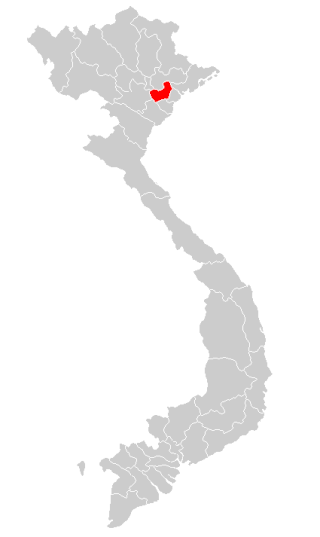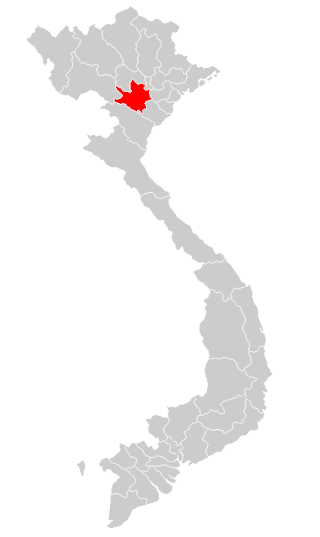
On the first tier, Vietnam is divided into fifty-eight provinces (tỉnh) and five municipalities under the command of the central government. Municipalities are the highest-ranked cities in Vietnam. Municipalities are centrally-controlled cities and have special status equal to the provinces.
Articles related to Vietnam and Vietnamese culture include:

Ninh Bình is a province of Vietnam in the Red River Delta region of the northern part of the country. The province is famous for a high density of natural and cultural attractions, including reserved parks in Cúc Phương National Park and Vân Long, grotto caves and rivers in Tràng An, Tam Cốc-Bích Động and Múa Caves, historic monuments in the Hoa Lư ancient capital, Vietnam's largest buddhist worshiping complex, and the Phát Diệm Cathedral with "eclectic architectural style". Thanks to its adjacency to Hanoi, day trips from the capital are easily manageable.

Hưng Yên is a province in the Red River Delta of northern Vietnam. It covers an area of 930.22 km2 (359.2 sq mi), comprising 1 city, 8 rural districts, and 1 district-leveled town, it had a population of 1,269,090 in 2021 with 209,726 people in urban areas and 1,059,364 people in rural areas. The province is a settlement along the banks of the Red River, bordered by 5 provinces and municipalities.

Hải Dương is a city in Vietnam. It is the capital of Hải Dương, an industrialized province in the Hanoi Capital Region and the Red River Delta in Northern Vietnam. The city is at the midpoint between the capital Hanoi and the major port Haiphong, and is part of the Northern Key Economic Zone. In 2019, Hai Duong city had a population of 241,373.
Dong Son may refer to several places in Vietnam, including:

Lệ Thủy is a district of Quảng Bình province in the North Central Coast of Vietnam. The district borders Quảng Ninh district on the north, Vĩnh Linh district on the south, Laos on the west. Lệ Thủy central is 40 km south of the provincial capital Đồng Hới. The district government seat is Kiến Giang Township. The district area is 1420.52 km2, population: 140,804 (1998). Lệ Thủy district is home to Võ Nguyên Giáp and the family of Ngô Đình Diệm. Economy bases on agriculture, mainly rice culture. Mỹ Trạch massacre by French army happened here on 29 November 1947.

Ba Vì is a district of Hanoi, Vietnam. Ba Vì district was established on July 26, 1968.
Phú Xuyên is a district (huyện) of Hanoi in the Red River Delta region of Vietnam.
Tan Thanh may refer to several populated places in Vietnam:

Hải Hậu is a rural district of Nam Định province in the Red River Delta region of Vietnam. As of 2003 the district had a population of 285,298. The district covers an area of 227 km². The district capital lies at Yên Định.

Đồng Hỷ is a rural district of Thái Nguyên province in the Northeast region of Vietnam. As of April 1, 2019, the district had a population of 92.421. The district covers an area of 427,73 km2. The district capital lies at Hóa Thượng.

Hanoi Capital Region or Hanoi Metropolitan Area is a metropolitan area currently planned by the government of Vietnam. This metropolitan area was created by decision 490/QD-TTg dated May 5, 2008 of the Prime Minister of Vietnam. Hanoi will be the core city of this metropolitan area. Other component parts will include provinces: Vĩnh Phúc Province, Hưng Yên Province, Bắc Ninh Province, Hải Dương Province, Hà Nam Province, Hòa Bình, Bắc Giang Province, Phú Thọ Province and Thái Nguyên Province with an area of 24.314,7 km², half of the size of Greater Ho Chi Minh City, the same for population size planning.
The Ministry of Industry and Trade is the government ministry in Vietnam responsible for the advancement, promotion, governance, regulation, management and growth of industry and trade. The former Ministry of Trade has its origins in 1945 with the formation of the modern National Unification Cabinet, and became a ministry in its own right in 1955. The Ministry of Trade merged with the Ministry of Industry in 2007 to form the Ministry of Industry and trade. The current Minister of Industry and Trade is Nguyễn Hồng Diên. Ministry main offices are located in Hanoi.
Đào Xá, is a very common name of many villages in rural northern Vietnam. Many villages are named Dao Xa village traditional identity or the historical cultural attractions.

Hải Hưng is a former province in the Red River Delta of Vietnam. It was established in 1968. On November 6, 1996, Hai Hung was split into two provinces: Hải Dương and Hưng Yên. The capital of Hải Hưng is Hải Dương. Hải Hưng had 1 town, and 10 districts: Chí Linh, Kim Môn, Nam Thanh, Cẩm Bình, Tứ Lộc, Ninh Thanh, Mỹ Văn, Châu Giang, Kim Thi and Phù Tiên.

Bình Trị Thiên (1975–1990) was a former administrative grouping of three provinces in Vietnam: Quảng Bình, Quảng Trị and Thừa Thiên. The grouping did not work well and was reversed in 1992. The geographical term had been used previously, for example in relation to culture, folk songs (1967) and is still used after, for example in relation to dialect (1997) and folk songs again (1997).

Ha Son Binh is a former province in North Vietnam from December 27-year 1975 to August 12-year 1991 on the basis of the merger of the two provinces Ha Tay and Hoa Binh.